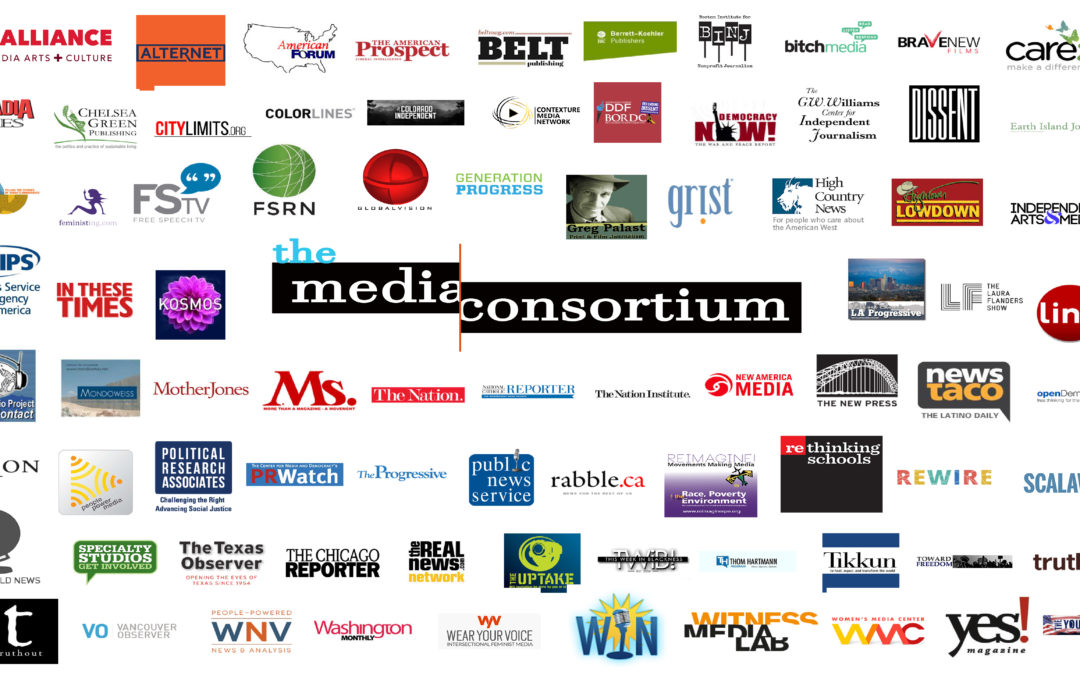View the full Media Consortium archive here.
Background
In the wake of George W. Bush’s second-term victory in 2004, several left-leaning news outlets met with the goal of forming a coalition to encourage collaboration between independent news media and increasing the impact of progressive independent media outlets in the United States.
What came of that meeting and the ones that followed was The Media Consortium. Officially founded in 2005, The Media Consortium (TMC) served independent media until its dissolution in 2018, by which time the Chicago-based alliance had become a network of more than 80 independent, progressive media organizations spanning print, radio, TV, and digital platforms and whose mission statement was as follows:
“We, the makers and providers of progressive, independent journalism, declare out intent to form among ourselves a new nonprofit association, The Media Consortium. Its purpose will be to amplify our voices; increase our collective clout; leverage our current audience and reach out to new ones; transform our sector’s position in a rapidly changing media and political environment; and redefine ourselves and progressivism for a new century.
We will pursue these goals through such concrete and practical efforts as are more effective when undertaken jointly. We believe it is possible and necessary to seize the current moment and change the debate in this country. Therefore, the mission of the Media Consortium is of vital importance for the health of American democracy.”
How did TMC work?
Over its 14-year run, The Media Consortium operated as a multi-platform network; the participating members included some of the leading independent magazines in the country: satellite television networks, radio networks and content producers, book publishers, film production units, and online-only media operations. The network grew to include some of the leading independent publishers and outlets such as Mother Jones, The Nation, Truthdig, AlterNet, Grist, and Democracy Now!, to name a few.
So many fiercely independent outlets agreed to work together and cooperate with the goals of expanding their reach, increasing public awareness they were reporting on, and learning how to run their businesses more effectively in what was, at the time, becoming and increasing digital age. “We wanted to think hard together about why, with all this great reporting and information, we had so little impact [on the election],” said Jay Harris, one of the founders of The Media Consortium.
At the time of the consortium’s conception, its founders sensed that news media was in the beginning stages of a major shift into the digital world; Facebook had just been launched, followed swiftly after by YouTube, and the rise of Twitter and smartphones were only a few years away. The Media Consortium acted as a means for independent outlets to prepare for the change and learn from established independent bloggers who knew how to effectively attract audiences in the digital world.
The Impact
A significant impact of The Media Consortium was that independent outlets had the chance to gain a greater understanding of who was consuming progressive media. Founding members of TMC realized from the start that they needed more diversity and more media that spoke to POC and young people; independent outlets needed to move away from catering to a primarily white audience and broaden their reach.
Over the course of The Media Consortium’s run, outlets that were comprised of all or mostly white staff became more inclusive. Non-corporate news became more accessible to people outside of the white, neoliberal bubble, and independent outlets made efforts to move away from ‘parachute journalism’ and work to engage more deeply with communities to gain a better understanding of the issues they cared about, thus increasing their audiences.
Above all, The Media Consortium proved that large scale cooperation and collaboration among independent media outlets – a culture that had not previously existed – was possible. The Media Consortium’s goal was to collaborate, share ideas and strategies, and overall increase their reach and impact across the U.S.
Maya Schenwar is the editor in Chief of Truthout (which joined TMC in 2010) and served as the chair of TMC’s coordinating committee for several years. “TMC amplified the work of each independent media outlet by connecting us together,” says Schenwar. “We reprinted each other more, lifted up each other’s work, collaborated, and even helped each other fundraise as a result of TMC.”
By the time it shut down, the consortium had done what it had set out to accomplish. While the consortium did end its operations, its influence lives on in other similar networks and organizations that followed it and continue their work today, such as the Institute for Nonprofit News (INN) and Local Independent Online News (LION).
However, the most important organization to spin out of the Media Consortium was PressOn.media.
“Independent news has often been on the cutting edge of changes in the news system,” says Jo Ellen Green Kaiser, who served as the Executive Director of The Media Consortium from 2011-2018. Jo Ellen, who provided the materials within this archive, expressed, “The things that you see in the archive around going digital and collaboration – [independent media has] been on the leading edge of all of these things. I think its useful for journalism students to be able to see that we were doing this ten years before it became a standard practice.”
It is our hope that this archive will provide students, journalists, and anyone with a curiosity toward independent media with an understanding of the kind of work that goes into running a network of such size and scope, as well as insight as to the history and accomplishments of this association.

